劳动经济学 第五章
- 格式:ppt
- 大小:103.50 KB
- 文档页数:21
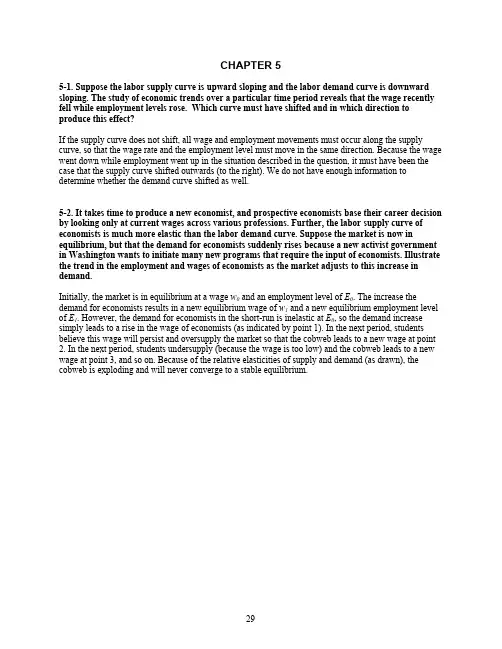
CHAPTER 55-1. Suppose the labor supply curve is upward sloping and the labor demand curve is downward sloping. The study of economic trends over a particular time period reveals that the wage recently fell while employment levels rose. Which curve must have shifted and in which direction to produce this effect?If the supply curve does not shift, all wage and employment movements must occur along the supply curve, so that the wage rate and the employment level must move in the same direction. Because the wage went down while employment went up in the situation described in the question, it must have been the case that the supply curve shifted outwards (to the right). We do not have enough information to determine whether the demand curve shifted as well.5-2. It takes time to produce a new economist, and prospective economists base their career decision by looking only at current wages across various professions. Further, the labor supply curve of economists is much more elastic than the labor demand curve. Suppose the market is now in equilibrium, but that the demand for economists suddenly rises because a new activist government in Washington wants to initiate many new programs that require the input of economists. Illustrate the trend in the employment and wages of economists as the market adjusts to this increase in demand.Initially, the market is in equilibrium at a wage w0 and an employment level of E0. The increase the demand for economists results in a new equilibrium wage of w1 and a new equilibrium employment level of E1. However, the demand for economists in the short-run is inelastic at E0, so the demand increase simply leads to a rise in the wage of economists (as indicated by point 1). In the next period, students believe this wage will persist and oversupply the market so that the cobweb leads to a new wage at point 2. In the next period, students undersupply (because the wage is too low) and the cobweb leads to a new wage at point 3, and so on. Because of the relative elasticities of supply and demand (as drawn), the cobweb is exploding and will never converge to a stable equilibrium.5-3. Suppose the supply curve of physicists is given by w = 10 + 5E , while the demand curve is given by w = 50 – 3E . Calculate the equilibrium wage and employment level. Suppose now that the demand for physicists increases and the new demand curve is given by w = 70 – 3E . Assume this market is subject to cobwebs. Calculate the wage and employment level in each round as the wage and employment levels adjust to the demand shock. (Recall that each round occurs on the demand curve – when the firm posts a wage and hires workers). What is the new equilibrium wage and employment level?The initial equilibrium is given by 10 + 5E = 50 – 3E . Solving these two equations simultaneously implies that w = $35 and E S = E D = 5. When demand increases to w = 70 – 3E , the new equilibrium wage is $47.5 and the equilibrium level of employment is 7.5.Round Wage Employment1 $55.0 52 $43.0 93 $50.2 6.64 $45.9 8.05 $48.4 7.26 $46.9 7.77 $47.8 7.48 $47.2 7.6The table gives the values for the wage and employment levels in each round. The values in the table are calculated by noting that in any given period the number of physicists is inelastically supplied, so that the wage is determined by the demand curve. Given this wage, the number of economists available in the next period is calculated. By round 7, the market wage rate is within 30 cents of the new equilibrium.01 w 1w 0W age5-4. The 1986 Immigration Reform and Control Act (IRCA) made it illegal for employers in the United States to knowingly hire illegal aliens. The legislation, however, has not reduced the flow of illegal aliens into the country. As a result, it has been proposed that the penalties against employers who break the law be increased substantially. Suppose that illegal aliens, who tend to be less skilled workers, are complements with native workers. What will happen to the wage of native workers if the penalties for hiring illegal aliens increase?A substantial increase in the penalties associated with hiring illegal aliens will likely reduce the number of illegal aliens entering the United States. The effect of this shift in the size of the illegal alien flow on the marginal product (and hence the demand curve) of native workers hinges on whether illegal aliens are substitutes or complements with natives. As it is assumed that natives and illegal aliens are complements, a cut in the number of illegal aliens reduces the value of the marginal product of natives, shifting down the demand for native labor, and decreasing native wages and employment.5-5. Suppose a firm is a perfectly discriminating monopsonist. The government imposes a minimum wage on this market. What happens to wages and employment?A perfectly discriminating monopsonist faces a marginal cost of labor curve that is identical to the supply curve. As a result, the employment level of a perfectly discriminating monopsonist equals theemployment level that would be observed in a competitive market (at E *) The imposition of a minimum wage at w MIN leads to the same result as in a competitive market: the firm will only want to hire E D workers as w MIN is now the marginal cost of labor, but E S workers will want to find work at the minimum wage. Thus, the wage increases, but employment falls.DollarsE w w *S D5-6. What happens to wages and employment if the government imposes a payroll tax on amonopsonist? Compare the response in the monopsonistic market to the response that would have been observed in a competitive labor market.Initially, the monopsonist hires E M workers at a wage of w M . The imposition of a payroll tax shifts the demand curve to VMP ′, and lowers employment to E ′ and the wage to w ′. Thus, the effect of imposing a payroll tax on a monopsonist is qualitatively the same as imposing a payroll tax in a competitive labor market: lower wages and employment. (It is interesting to note that the same result comes about if the payroll tax is placed on workers, so that the labor supply and marginal cost of labor curves shift as opposed to labor demand.)5-7. An economy consists of two regions, the North and the South. The short-run elasticity of labor demand in each region is –0.5. The within-region labor supply is perfectly inelastic. The labormarket is initially in an economy-wide equilibrium, with 600,000 people employed in the North and 400,000 in the South at the wage of $15 per hour. Suddenly, 20,000 people immigrate from abroad and initially settle in the South. They possess the same skills as the native residents and also supply their labor inelastically.(a) What will be the effect of this immigration on wages in each of the regions in the short run (before any migration between the North and the South occurs)?There will be no effect on the North’s labor supply in the short run, so the wage rate will not change there. In the South, labor supply will have increased by 5 percent, so the wage rate must fall by 5/(0.5) = 10 percent (recall that the elasticity of labor demand is -0.5, so a one percent decrease in wages would have been generated by a 0.5 percent expansion of the labor supply). The new hourly wage in the South, therefore, is $13.50 and total employment in the South is 420,000.DollarsEmploymentw M w ′(b) Suppose 1,000 native-born persons per year migrate from the South to the North in response to every dollar differential in the hourly wage between the two regions. What will be the ratio of wages in the two regions after the first year native labor responds to the entry of the immigrants?After the initial migration, we have seen that wages in the South are $13.50 while wages in the North are $15. This difference leads 1,500 natives migrating from the South to the North in the first year. Employment in the North after one year, therefore is 601,500. Moreover, as the elasticity of labor demand in the North is -0.5 and employment has increased by 0.25 percent, the Northern wage falls by 0.5 percent to roughly $14.93. Likewise, employment in the South after one year is 418,500. As the elasticity of labor demand is -0.5 and employment has decreased by 0.3571 percent, the Southern wage increases by0.71428 percent to roughly $13.60. Thus, the ratio of the Northern to Southern wage after one year is1.09779.(c) What will be the effect of this immigration on wages and employment in each of the regions in the long run (after native workers respond by moving across regions to take advantage of whatever wage differentials may exist)? Assume labor demand does not change in either region.In the long run, people must move from the South to the North to equalize the wage rates in the two regions. Since the wages were equal in the two regions before the influx of immigrants, and they also must be equal after things settle down, the proportional decrease in the wage rate should be the same in the North and in the South. Because the elasticity of labor demand is the same in the two regions, this last observation implies that the percentage increase in employment in the North must be the same as the percentage increase in employment in the South. Thus, as 60 percent of the original workers were employed in the North, 60 percent of the 20,000 increase in Southern employment will eventually migrate to the North. In the long run, therefore, total Northern employment will be 612,000 while total Southern employment will be 408,000. (Note: there is no presumption that only immigrants further migrate to the North.) In each region, therefore, employment increases by 2 percent in the long run, i.e., 12,000 is 2 percent of 600,000 and 8,000 is 2 percent of 400,000. (This can also be seen immediately as 20,000 is 2 percent of the 1 million workers.) Now, given that the elasticity of labor demand is -0.5, the 2 percent increase in employment will cause the wage rate to fall by 4 percent. Hence, the long-run equilibrium hourly wage will be $14.40.5-8. Chicken Hut faces perfectly elastic demand for chicken dinners at a price of $6 per dinner. The Hut also faces an upward sloped labor supply curve ofE = 20w – 120,where E is the number of workers hired each hour and w is the hourly wage rate. Thus, the Hut faces an upward sloped marginal cost of labor curve ofMC E = 6 + 0.1E.Each hour of labor produces 5 dinners. (The cost of each chicken is $0 as the Hut receives two-day old chickens from Hormel for free.) How many workers should Chicken Hut hire each hour to maximize profits? What wage will Chicken Hut pay? What are Chicken Hut’s hourly profits?First, solve for the labor demand curve: VMP E = P x MP E = $6 x 5 = $30. Thus, every worker is valued at $30 per hour by Chicken Hut. Now, setting VMP E = MC E yields 30 = 6 + .1E which implies E* = 240. Thus, Chicken Hut will hire 240 workers every hour. Further, according to the labor supply curve, 240 workers can be hired at an hourly wage of $18. Finally, Chicken Hut’s profits are Π = 240(5)($6) –240($18) = $2,880.5-9. Polly’s Pet Store has a local monopoly on the grooming of dogs. The daily inverse demand curve for pet grooming is:P = 20 – 0.1Qwhere P is the price of each grooming and Q is the number of groomings given each day. This implies that Polly’s marginal revenue is:MR = 20 – 0.2Q.Each worker Polly hires can groom 20 dogs each day. What is Polly’s labor demand curve as a function of w, the daily wage that Polly takes as given?As each worker can groom 20 dogs each day, and using Q = 20E, we have thatVMP E = MR x MP E = ( 20 – 0.2Q ) (20) = (20 – 4E)(20) = 400 – 80E.Thus, as Polly’s demand for labor satisfies VMP E = w, we have that her labor demand curve isE = 5 – 0.0125w.5-10. The Key West Parrot Shop has a monopoly on the sale of parrot souvenir caps in Key West. The inverse demand curve for caps is:P = 30 – 0.4 Qwhere P is the price of a cap and Q is the number of caps sold per hour. Thus, the marginal revenue for the Parrot Shop is:MR = 30 – 0.8Q.The Parrot Shop is the only employer in town, and faces an hourly supply of labor given by:w = 0.9E + 5where w is the hourly wage rate and E is the number of workers hired each hour. The marginal cost associated with hiring E workers, therefore, is:MC E = 1.8E + 5.Each worker produces two caps per hour. How many workers should the Parrot Shop hire each hour to maximize its profit? What wage will it pay? How much will it charge for each cap?First, as Q = 2E, the labor demand curve isVMP E = MR x MP E = (30 – 0.8Q)(2) = 60 – 1.6Q = 60 – 3.2E.Setting VMP E equal to MC E and solving for E yields E = 11. Eleven workers can be hired at a wage of.9(11) + 5 = $14.99 per hour. The 11 workers make 22 caps each hour, and the 22 caps can be sold at a price of 30 – 0.4(22) = $21.20 each.5-11. Ann owns a lawn mowing company. She has 400 lawns she needs to cut each week. Her weekly revenue from these 400 lawns is $20,000. If given an 18-inch deck push mower, a low-skill worker can cut each lawn in two hours. If given a 60-inch deck riding mower, a low-skill worker can cut the lawn in 30 minutes. Low-skilled labor is supplied inelastically at $5.00 per hour. Each laborer works 8 hours a day and 5 days each week.(a) If Ann decides to have her workers use push mowers, how many push mowers will Ann rent and how many workers will she hire?As each worker can cut a lawn in 2 hours, it follows that each worker can cut 4 lawns in a day or 20 lawns in a week. Therefore, Ann would need to rent 20 push mowers and hire 20 workers in order to cut all 400 lawns each week.(b) If she decides to have her workers use riding mowers, how many riding mowers will Ann rent and how many workers will she hire?As each worker can cut a lawn in 30 minutes, it follows that each worker can cut 16 lawns in a day or 80 lawns in a week. Therefore, Ann would need to rent 5 riding mowers and hire 5 workers in order to cut all 400 lawns each week.(c) Suppose the weekly rental cost (including gas and maintenance) for each push mower is $250 and the weekly rental cost (including gas and maintenance) of each riding mower is $1,800. What equipment will Ann rent? How many workers will she employ? How much profit will she earn?If Ann uses push mowers, her weekly cost of mowers is $250(20) = $5,000 while her weekly labor cost is $5(20)(40) = $4,000. Under this scenario, her weekly profit is $11,000. If Ann uses riding mowers, her weekly cost of mowers is $1,800(5) = $9,000 while her weekly labor cost is $5(5)(40) = $1,000. Thus, under this scenario, her weekly profit is $10,000. Therefore, under these conditions, Ann will rent 20 push mowers and employ 20 low-skill workers.(d) Suppose the government imposes a 20 percent payroll tax (paid by employers) on all labor and offers a 20 percent subsidy on the rental cost of capital. What equipment will Ann rent? How many workers will she employ? How much profit will she earn?Under these conditions, the cost of labor has increased to $6.00 per hour, while the rental costs for a push mower and a riding mower have decreased to $200 and $1,440 respectively. Ann’s profits under the two options, therefore, arePush-Profit = $20,000 – $200(20) – $6(20)(40) = $11,200.Rider-Profit = $20,000 – $1,440(5) – $6(5)(40) = $11,600.Thus, under these conditions, Ann rents riding mowers, hires 5 low-skill workers, and earns a weekly profit of $11,600.5-12. In the United States, some medical procedures can only be administered to a patient by a doctor while other procedures can be administered by a doctor, nurse, or lab technician. What might be the medical reasons for this? What might be the economic reasons for this?The American Medical Association might argue that doctors have more training and experience than nurses, and therefore, are the only professionals who can make certain decisions or perform certain procedures.Economically, the AMA has an incentive to restrict the number of people who can practice medicine (or perform certain procedures) in order to keep doctor wages high. If nurses were allowed to do everything they were capable of, fewer doctors would be demanded, and doctor wages would fall. From an economic viewpoint, therefore, the AMA restricts the supply of doctors, which keeps doctor wages artificially high.WageW restW unrestRestricted Supply ofDoctorsUnrestricted Supplyof DoctorsL rest L unrest Services Provided by DoctorsLabor Market For Medical Services Provided by Doctors。
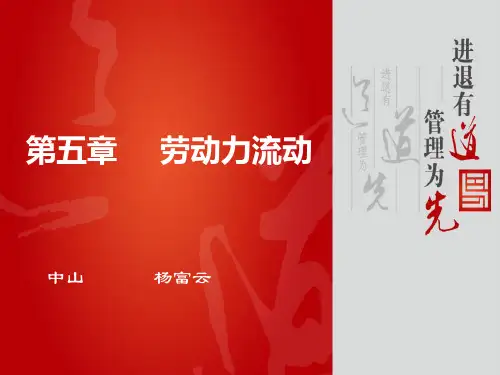
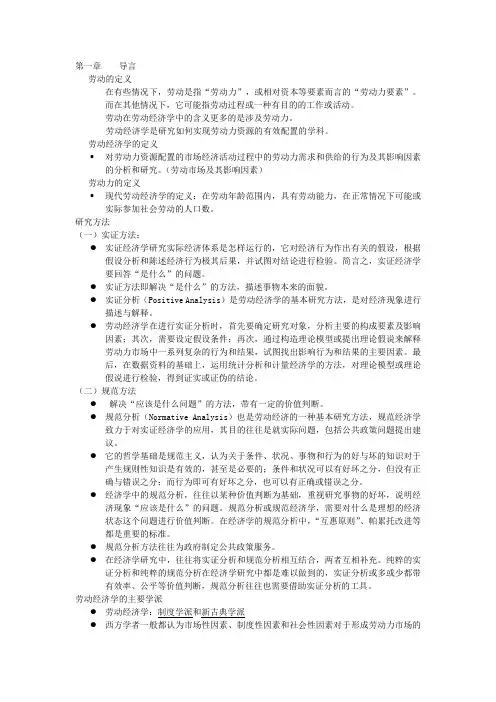
第一章导言劳动的定义在有些情况下,劳动是指“劳动力”,或相对资本等要素而言的“劳动力要素”。
而在其他情况下,它可能指劳动过程或一种有目的的工作或活动。
劳动在劳动经济学中的含义更多的是涉及劳动力。
劳动经济学是研究如何实现劳动力资源的有效配置的学科。
劳动经济学的定义▪对劳动力资源配置的市场经济活动过程中的劳动力需求和供给的行为及其影响因素的分析和研究。
(劳动市场及其影响因素)劳动力的定义▪现代劳动经济学的定义:在劳动年龄范围内,具有劳动能力,在正常情况下可能或实际参加社会劳动的人口数。
研究方法(一)实证方法:●实证经济学研究实际经济体系是怎样运行的,它对经济行为作出有关的假设,根据假设分析和陈述经济行为极其后果,并试图对结论进行检验。
简言之,实证经济学要回答“是什么”的问题。
●实证方法即解决“是什么”的方法,描述事物本来的面貌。
●实证分析(Positive Analysis)是劳动经济学的基本研究方法,是对经济现象进行描述与解释。
●劳动经济学在进行实证分析时,首先要确定研究对象,分析主要的构成要素及影响因素;其次,需要设定假设条件;再次,通过构造理论模型或提出理论假说来解释劳动力市场中一系列复杂的行为和结果,试图找出影响行为和结果的主要因素。
最后,在数据资料的基础上,运用统计分析和计量经济学的方法,对理论模型或理论假说进行检验,得到证实或证伪的结论。
(二)规范方法●解决“应该是什么问题”的方法,带有一定的价值判断。
●规范分析(Normative Analysis)也是劳动经济的一种基本研究方法,规范经济学致力于对实证经济学的应用,其目的往往是就实际问题,包括公共政策问题提出建议。
●它的哲学基础是规范主义,认为关于条件、状况、事物和行为的好与坏的知识对于产生规则性知识是有效的,甚至是必要的;条件和状况可以有好坏之分,但没有正确与错误之分;而行为即可有好坏之分,也可以有正确或错误之分。
●经济学中的规范分析,往往以某种价值判断为基础,重视研究事物的好坏,说明经济现象“应该是什么”的问题。
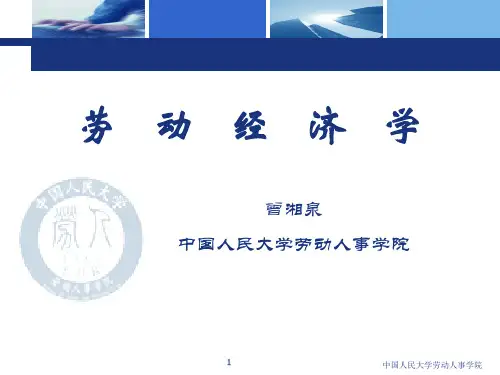

劳动经济学学习要点(五)——第五节就业与失业2020年5月22日,国务院总理李克强代表国务院向十三届全国人大三次会议所作的政府工作报告,多次提出稳就业、保就业以及控制失业率。
那么什么是就业?什么是失业?什么是失业率?下面就讲解就业与失业。
一、就业总量的决定理论(一)就业的含义所谓就业或劳动就业一般是指有劳动能力和就业要求的人,参与某种社会劳动,并通过劳动获得报酬或经营收入的经济活动。
凡是从事社会劳动并取得劳动报酬或经营收入的劳动者,即为就业者。
就业包含三层含义:第一,劳动就业的主体是有劳动能力和就业要求的人,能够参加某种劳动。
劳动能力的重要条件之一是必须达到法定最低就业年龄。
未达到法定最低就业年龄的人,一般可以视为无劳动能力,不能以自己的行为行使劳动权利,承担劳动给付的义务。
第二,所参加的劳动属于社会劳动,对社会有益。
第三,所从事的劳动为有酬劳动,既可以是劳动报酬,也可以是经营收入。
只有同时具备上述三个条件,才可以称为就业。
(二)总供给、总需求与均衡国民收入1、总供给概念。
所谓总供给,是指一国在一定时期内生产的最终产品和服务按价格计算的货币价值总量。
从产品和服务的生产看,它取决于用于生产的各类生产要素投入的总规模;从收入分配看,它是一定时期内要素投入而获得的收入总和。
所以,总供给等同于一定时期的国民生产总值或国民收入。
在生产要素的报酬收入中,一部分用于购买消费品和服务的支出,部分用于储蓄。
因此,总供给也等于消费与储蓄的总和。
用公示表达:总供给=各类生产要素供给的总和(劳动+资本+土地+管理)=各类生产要素相应的收入的总和=消费十储蓄2、总需求概念。
所谓总需求,是指社会在一定时期内对产品和服务需求的总和,这里假设总需求只包括消费品的需求和投资品的需求。
消费品的需求是指居民户对各类消费品的支出、住房租金以及其他服务支出的总和。
投资品的需求是指企业用于厂房、设备等固定资产的投资,用于原材料、半成品和存货增量的支出等。
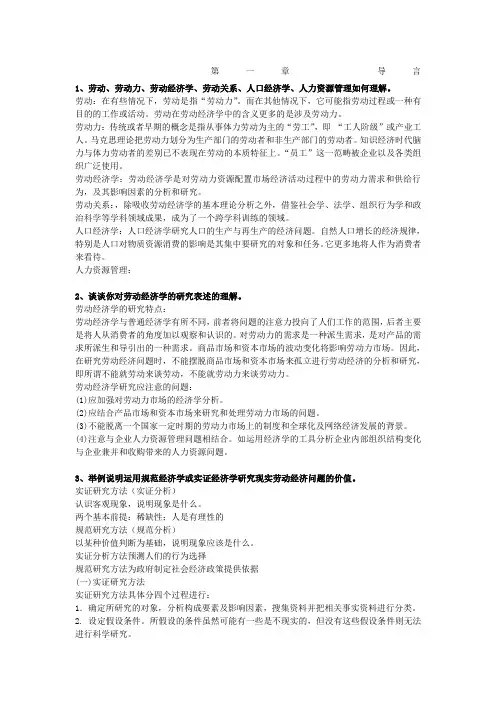
第一章导言1、劳动、劳动力、劳动经济学、劳动关系、人口经济学、人力资源管理如何理解。
劳动:在有些情况下,劳动是指“劳动力”。
而在其他情况下,它可能指劳动过程或一种有目的的工作或活动。
劳动在劳动经济学中的含义更多的是涉及劳动力。
劳动力:传统或者早期的概念是指从事体力劳动为主的“劳工”,即“工人阶级”或产业工人。
马克思理论把劳动力划分为生产部门的劳动者和非生产部门的劳动者。
知识经济时代脑力与体力劳动者的差别已不表现在劳动的本质特征上。
“员工”这一范畴被企业以及各类组织广泛使用。
劳动经济学:劳动经济学是对劳动力资源配置市场经济活动过程中的劳动力需求和供给行为,及其影响因素的分析和研究。
劳动关系:,除吸收劳动经济学的基本理论分析之外,借鉴社会学、法学、组织行为学和政治科学等学科领域成果,成为了一个跨学科训练的领域。
人口经济学:人口经济学研究人口的生产与再生产的经济问题。
自然人口增长的经济规律,特别是人口对物质资源消费的影响是其集中要研究的对象和任务。
它更多地将人作为消费者来看待。
人力资源管理:2、谈谈你对劳动经济学的研究表述的理解。
劳动经济学的研究特点:劳动经济学与普通经济学有所不同,前者将问题的注意力投向了人们工作的范围,后者主要是将人从消费者的角度加以观察和认识的。
对劳动力的需求是一种派生需求,是对产品的需求所派生和导引出的一种需求。
商品市场和资本市场的波动变化将影响劳动力市场。
因此,在研究劳动经济问题时,不能摆脱商品市场和资本市场来孤立进行劳动经济的分析和研究,即所谓不能就劳动来谈劳动,不能就劳动力来谈劳动力。
劳动经济学研究应注意的问题:(1)应加强对劳动力市场的经济学分析。
(2)应结合产品市场和资本市场来研究和处理劳动力市场的问题。
(3)不能脱离一个国家一定时期的劳动力市场上的制度和全球化及网络经济发展的背景。
(4)注意与企业人力资源管理问题相结合。
如运用经济学的工具分析企业内部组织结构变化与企业兼并和收购带来的人力资源问题。
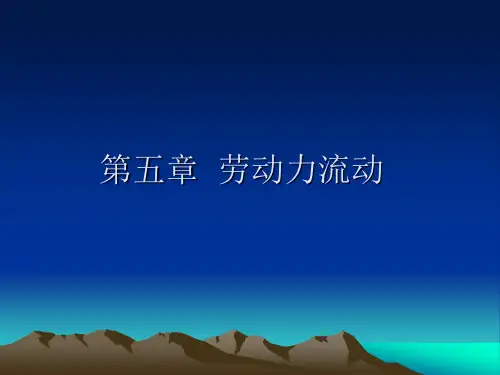
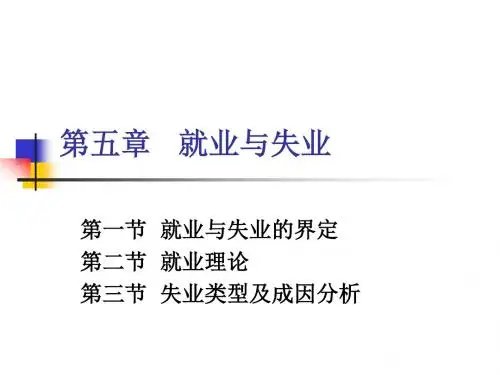

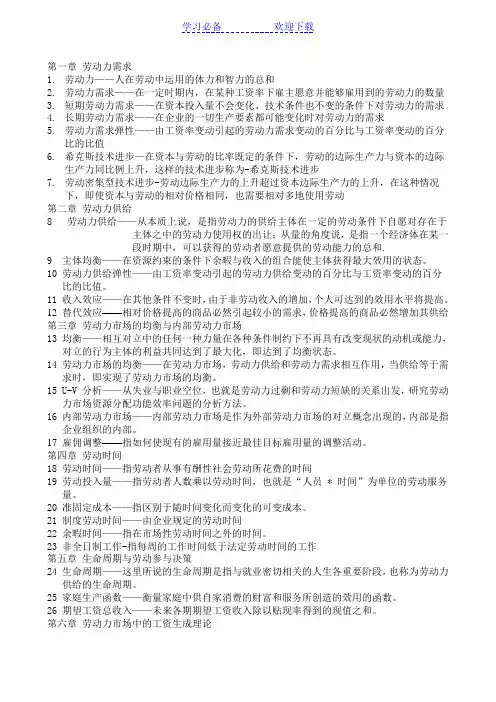
第一章劳动力需求1.劳动力——人在劳动中运用的体力和智力的总和2.劳动力需求——在一定时期内,在某种工资率下雇主愿意并能够雇用到的劳动力的数量3.短期劳动力需求——在资本投入量不会变化、技术条件也不变的条件下对劳动力的需求4.长期劳动力需求——在企业的一切生产要素都可能变化时对劳动力的需求5.劳动力需求弹性——由工资率变动引起的劳动力需求变动的百分比与工资率变动的百分比的比值6.希克斯技术进步—在资本与劳动的比率既定的条件下,劳动的边际生产力与资本的边际生产力同比例上升,这样的技术进步称为-希克斯技术进步7.劳动密集型技术进步-劳动边际生产力的上升超过资本边际生产力的上升,在这种情况下,即使资本与劳动的相对价格相同,也需要相对多地使用劳动第二章劳动力供给8 劳动力供给——从本质上说,是指劳动力的供给主体在一定的劳动条件下自愿对存在于主体之中的劳动力使用权的出让;从量的角度说,是指一个经济体在某一段时期中,可以获得的劳动者愿意提供的劳动能力的总和.9主体均衡——在资源约束的条件下余暇与收入的组合能使主体获得最大效用的状态。
10劳动力供给弹性——由工资率变动引起的劳动力供给变动的百分比与工资率变动的百分比的比值。
11收入效应——在其他条件不变时,由于非劳动收入的增加,个人可达到的效用水平将提高。
12替代效应——相对价格提高的商品必然引起较小的需求,价格提高的商品必然增加其供给第三章劳动力市场的均衡与内部劳动力市场13均衡——相互对立中的任何一种力量在各种条件制约下不再具有改变现状的动机或能力,对立的行为主体的利益共同达到了最大化,即达到了均衡状态。
14劳动力市场的均衡——在劳动力市场,劳动力供给和劳动力需求相互作用,当供给等于需求时,即实现了劳动力市场的均衡。
15U-V 分析——从失业与职业空位,也就是劳动力过剩和劳动力短缺的关系出发,研究劳动力市场资源分配功能效率问题的分析方法。
16内部劳动力市场——内部劳动力市场是作为外部劳动力市场的对立概念出现的,内部是指企业组织的内部。
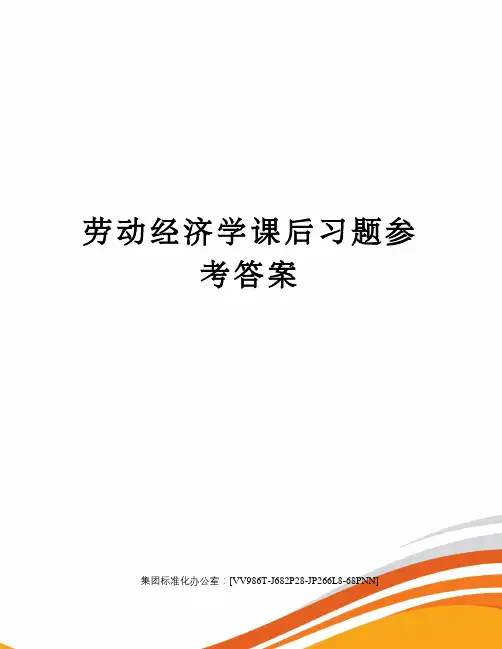
劳动经济学课后习题参考答案集团标准化办公室:[VV986T-J682P28-JP266L8-68PNN]《劳动经济学》课后思考题参考答案第一章绪论二、思考题1.如何理解劳动经济学的价值(1)劳动经济学研究的是社会经济问题。
例如,民工荒、政府要求增加最低工资、劳动生产率下降、农民工工资急剧上升、工资增长不均等、工作培训、国有企业高管人员的高工资受到质疑、收入分配不平、农村移民增加、劳动力市场全球化扩大等等。
(2)数量上的重要性。
在西方经济中,大部分国民收入并不是来源于资本收入(利润、租金和利息),而是来源于工资。
绝大多数居民户的主要收入来源是提供劳务。
从数量上看,劳动才是我们最重要的经济资源。
(3)独有的特性。
劳动力市场的交易完全不同于产品市场的交易。
劳动力市场是一个极有意义和复杂的场所。
劳动力市场的复杂性意味着供给和需求概念在应用于劳动力市场时必须做出重大的修改和调整。
在供给方面,劳动者“出售”给雇主的劳务与该劳动者不可分离。
除了货币报酬,工人还关注工作的健康和安全性、工作难度、就业稳定性、培训和晋升机会等,这类非货币因素也许与直接收入同样重要。
这样,工人的供给决策要比产品市场的供给概念复杂得多。
(4)收益的广泛性。
无论是个人还是社会,都可以从劳动经济学中得到许多启示和教益。
从劳动经济学得到的信息和分析工具有助于人们做出与劳动力市场有关的决策。
从个人角度看。
大量内容将直接与我们有关,如工作搜寻、失业、歧视、工资、劳动力流动等。
对于企业管理者来说,从对劳动经济学的理解中所得到的知识背景和分析方法,对做出有关雇用、解雇、培训和工人报酬等方面的管理决策也应该是十分有用的。
从社会角度看,了解劳动经济学将使人们成为更有知识、更理智的公民。
2.劳动经济学的研究方法有哪些首先要明确劳动经济学的基本假设。
劳动经济学的假设主要表现在以下四个方面:(1)资源的相对稀缺性。
如同商品和资本是稀缺的一样,劳动力资源也是有限的。
《劳动经济学》课程网上考试题库第一章劳动力需求一、单项选择题1、马克思的劳动力商品理论认为:货币转化为资本的关键在于()。
A、劳动者具有人身自由B、劳动者丧失了一切生产资源和生活资料C、劳动力成为商品D、劳动生产率的变化答案:C2、在远古时期,在()著作中,热情讴歌了人类的劳动,认为只有劳动才能得到财富、荣誉、家庭和朋友。
A、赫西奥德的《劳动与时日》B、色诺芬的《经济论》C、色诺芬的《雅典的收入》D、柏拉图的《理想国》答案:A3、产业革命后,提出“劳动则为财富之父和能动的要素”观点的经济学家是()。
A、配第B、斯密C、李嘉图D、萨伊答案:A4、()标志着劳动经济学作为一门学科,进行独立发展阶段。
A、索罗门·布拉姆的《劳动经济学》著作出版B、20世纪30年代的“凯恩斯革命”C、20世纪40年代,芝加哥学派进行的“劳动经济学革命”D、我国朱九通教授所著的《劳动经济学概论》出版答案:A5、劳动经济学是经济学的重要分支,是一门研究()的学问。
A、劳动生产率B、劳动的人C、劳动资料D、劳动要素答案:B6、劳动力是指()A、人的劳动能力B、具有劳动能力的人“人”C、简单的生理劳动D、劳动答案:A7、劳动需求曲线向左下方向移动,说明劳动力需求()A、增加B、减少C、不变D、难以判定答案:B8、在1960年,提出了人力资本投资理论是()A、贝克尔B、舒尔茨C、马歇尔D、马克思答案:B9、马克思的相对过剩人口理论认为,相对过剩人口的存在形式不包括()A、流动的过剩人口B、潜在的过剩人口C、停滞的过剩人口D、固定的过剩人口答案:D10、在劳动力市场动态均衡模型中,动态均衡无法达到的条件是()A、劳动力供给弹性大于劳动力需求弹性B、劳动力供给弹性小于劳动力需求弹性C、劳动力供给弹性等于劳动力需求弹性D、工资率的波动对劳动力供给量的影响越来越小答案:A9、动态均衡分析是指在考察市场均衡时,变量的调整()A、没有抽象掉时间因素B、抽象掉了时间因素C、不需要花时间完成D、在同一时间内完成答案:A二、多项选择题1、造成工资国民差异的原因()。
第五章 劳动需求一、选择题1.劳动边际产品告诉我们A)哪个工人生产能力最高B)每个工人的平均产出C)最后一个被雇工人的追加产出D)厂商能从每个雇员那里赚多少钱2.边际报酬递减的产生是因为A) 雇佣的工人越多意味着每个工人拥有的资本越少;B) 当工人和资本存量都增加时,厂商的管理难度增加;C)最优秀的工人总是第一个被雇佣;D)雇佣更多的工人意味着他们将细分工作,所以工作更有效率表格 5-1工人数量罐子总产量/天0 01 62 133 184 215 236 223.参考表格5-1,边际报酬递减始于第个工人A) 1B) 2C) 3D) 64.参考表格5-1,以下哪项是不正确的。
如果每个罐子售价$20,则A)第二个工人劳动的边际收益产品是$260;B)第三个工人的边际产品是5个罐子;C)出售第十八个罐子的边际收益是$20;D)劳动的边际收益产品等于劳动的边际产品乘以每一单位产出的额外收益。
5. 参考表格5-1,如果每天的工资是$50.00,每个罐子售价为$20,厂商将雇佣多少制陶工人?A)2B)3C)4D)56.如果厂商雇佣工人使得劳动的边际费用大于劳动的边际收益产品,则A)增加雇用量可以增加利润。
B)减少雇用量可以增加利润。
C)利润可以最大化。
D)总成本一定大于总收益。
7.当决定一个体育明星的薪水时,A) 球队必须考虑体育明星应该挣多少钱。
B) 球队必须考虑体育明星可以使收益增加多少。
C) 球队估计体育明星的边际产品;因为这只是猜测,体育明星通常报酬没有给足。
D) 球队将雇佣体育明星,如果这样做可以增加球队的收益。
8.厂商短期的劳动需求曲线A)是向上倾斜的。
B) 是水平的。
C) 是边际收益图中向下倾斜的部分。
D) 是劳动边际产品图中向下倾斜的部分9.如果对雇主征税A) 工人不需要交税。
B) 工资和雇佣量通常都会减少。
C) 顾客不需要交税。
D) 工资将会下降,但是雇佣量会上升10.一个产品市场上的垄断厂商可能会A) 比完全竞争市场雇佣更多的工人。
第一章劳动力需求劳动力:1、是人所特有的一种能力。
2、是存在于活的人体中的能力。
3、是人在劳动中所运用的能力。
4、是人在劳动中运用的体力和智力的总和。
劳动力资源:指能够从事各类工作的劳动力人口,它是劳动力人口的数量和平均素质的乘积。
劳动力需求:指一定时期内,在某种工资率下雇主愿意并能够雇用到的劳动力数量。
1、劳动力需要是派生性需求。
2、边际生产率理论是劳动力需求理论的支持理论之一。
3、劳动意愿和支付能力的统一。
劳动力需求的假设:1、生产技术假设。
2、组织目标的假设。
3、市场环境的假设。
4、劳动力是否同质的假设。
边际生产力递减速规律:在短期,生产的其他要素固定不变,惟一可变的生产要素是劳动投入。
当把可变的劳动调入增加到不变的其他生产要素上时,最初劳动的增加会使产量增加;当增加超过一定量时,增加的产量开始递减。
劳动力需求弹性的五种状态:1、弹性等于零,此时为完全无弹性需求。
2、弹性小于1,无弹性。
3、弹性等于1,为单位弹性。
4、弹性大于1,劳动力需求弹性较大。
5、弹性无穷大。
称之为完全有弹性。
劳动力需求弹性一的决定要素:1要素替代:当其他因素保持不变时,在生产函数上,劳动投入与其他生产要素之间可替代性越大。
2、产品需求:当其他因素保持不变时,产品的需求弹性越大。
3、其他生产要素的供给弹性越大。
4、劳动力成本占总成本比重越大,劳动力需求弹性越大。
劳动力密集型行业中,劳动力在总成本中所占比重较高,所以工资的变动对就业水平产生较大影响,在资本密集型行业中,工资变动对就业水平的影响相对较小。
技术进步的三种类型:1、希克斯技术进步。
2、资本密集型技术进步。
3、劳动密集型技术进步。
第二章劳动力供给劳动力供给:指劳动力的供给主体在一定的劳动条件下自愿对存在于主体之中的劳动力使用权的出让,从量的角度上说,是指一个经济体在某一段时期中,可以获得的劳动者愿意并能够提供的劳动能力的总和。
总人口劳动参与率=劳动力人口/总人口*100%法定劳动年龄人口劳动力参与率=劳动办人口/法定劳动年龄人口*100%年龄性别劳动力参与率=某年龄(性别)劳动力人口/与分子同范围人*100%影响劳动力参与率的因素:1、教育制度与教育供给规模。
名词解释:1、派生需求:是由阿弗里德·马歇尔在其《经济学原理》一书中首次提出的经济概念,是指对生产要素的需求,意味着它是由对该要素参与生产的产品的需求派生出来的,又称“引致需求”。
对一种生产要素的需求来自(派生自)对另一种产品的需求。
其中该生产要素对这一最终产品会作贡献,如对轮胎的需求派生自对汽车运输的需求。
1.短期:在短期内可变的生产要素只有劳动力,技术和资本都是不变生产要素。
2.长期:在长期内,劳动力和技术是可变生产要素,只有资本是不变生产要素。
3.卖方垄断企业:指企业在产品市场上市垄断者,但在劳动市场上市完全竞争。
4.买方垄断企业:是指企业劳动力市场是垄断者,而在产品市场上是完全竞争者。
5.替代效应:劳动使用量从LA降低到LB,资本使用量从KA上升到KB,即企业用资本代替了劳动。
6.规模效应:由于工资率的提高,企业使用劳动的边际成本将上升,从而导致企业生产更少的数量,产量的下降将会导致使用劳动数量的下降,图中变现为从B点到C点的移动,劳动数量随之下降。
7.互补性生产要素:当生产要素A的价格下降,数量增加时,对生产要素B的需求上升,则称生产要素A与生产要素B是互补。
8.替代性生产要素:当生产要素A的价格下降,数量增加时,生产要素B的数量下降,则生产要素A是生产要素B的替代性生产要素。
9.劳动需求的工资弹性:a)劳动需求的工资弹性是指当工资率变化一个百分率所引起的劳动需求变化的百分率的比值。
b)公式:ed =-(△L/L)/(△W/W)=-(△L/△W)/(W/L)1.ed为劳动需求的工资弹性,△L和△W分别是劳动需求数量L和工资率W的变动量。
10、劳动的边际产品价值:VMP=MP•P,指的是增加额外一单位劳动要素的投入所带来的收益。
(三)1.劳动力:是人的劳动能力,即人在劳动过程中所运用的体力和智力的总和。
在现代劳动经济学体系中,劳动力又特指在一定年龄范围内,具有劳动能力和劳动要求。
第一章劳动力需求一.名词解释1劳动力需求2.劳动力需求弹性二.选择题1.劳动力需求的派生性决定了劳动力需求理论就是关于()。
A.消费的理论B.生产的理论C.分配的理论D.交换的理论2.由于增加一个单位的劳动要素投入而增加的产量,这是劳动的()。
A.总产量B.最大产量C.人均产量D.边际产量3.劳动的边际生产力递减规律发生作用的前提是()。
A.劳动力投入数量不变B.技术水平不变C.产出不变D.工资水平不变4.边际成本是指( )。
A.增加单位产量所增加的成本 B.增加单位劳动投入所增加的成本C.平均每一单位产量的成本D.平均每一单位劳动投入的成本5.边际技术替代率的表达公式为( )。
A.MRTS=AP L/AP K B.MRTS=AP K/AP LC.MRTS=MP L/MP KD.MRTS=TP K/TP L6.在其他生产要素不变时,由劳动投入增加引起的产量的变动可以分为()阶段。
A.一个 B.两个 C.三个 D.四个7.工资上升对劳动力需求产生的影响可分解为替代效应和 ( )。
A.需求效应B.派生效应C.收入效应D.规模效应8.在资本与劳动的比率既定的条件下,劳动的边际生产力与资本的边际生产力同比例上升,这样的技术进步称为 ( )。
A.希克斯技术进步B.资本密集型技术进步C.劳动密集型技术进步D.要素密集型技术进步9.当劳动力的需求弹性大于1时,劳动力需求变动的百分比 ( )工资变动的百分比。
A.小于 B.等于 C.大于 D.大于等于10.长期劳动力需求曲线比短期劳动力需求曲线 ( )。
A.陡峭 B.平缓 C.高 D.低11.对于边际生产力递减规律,下列说法正确的是()。
A.第一阶段边际产量递增B.第一阶段边际产量递减C.第二阶段边际产量递减D.第三阶段总产量增加E.第三阶段总产量绝对减少12.对于劳动力需求,正确的理解有( )。
A.是企业雇用意愿和支付能力的统一B.等同于劳动力需要C.同社会物质产品(服务)的需求一样,是一种绝对的需求D.是一种派生性需求E.产生的直接基础在于产品(服务)的需求三.判断1.关于劳动力需求的假设不包括生产技术的假设。